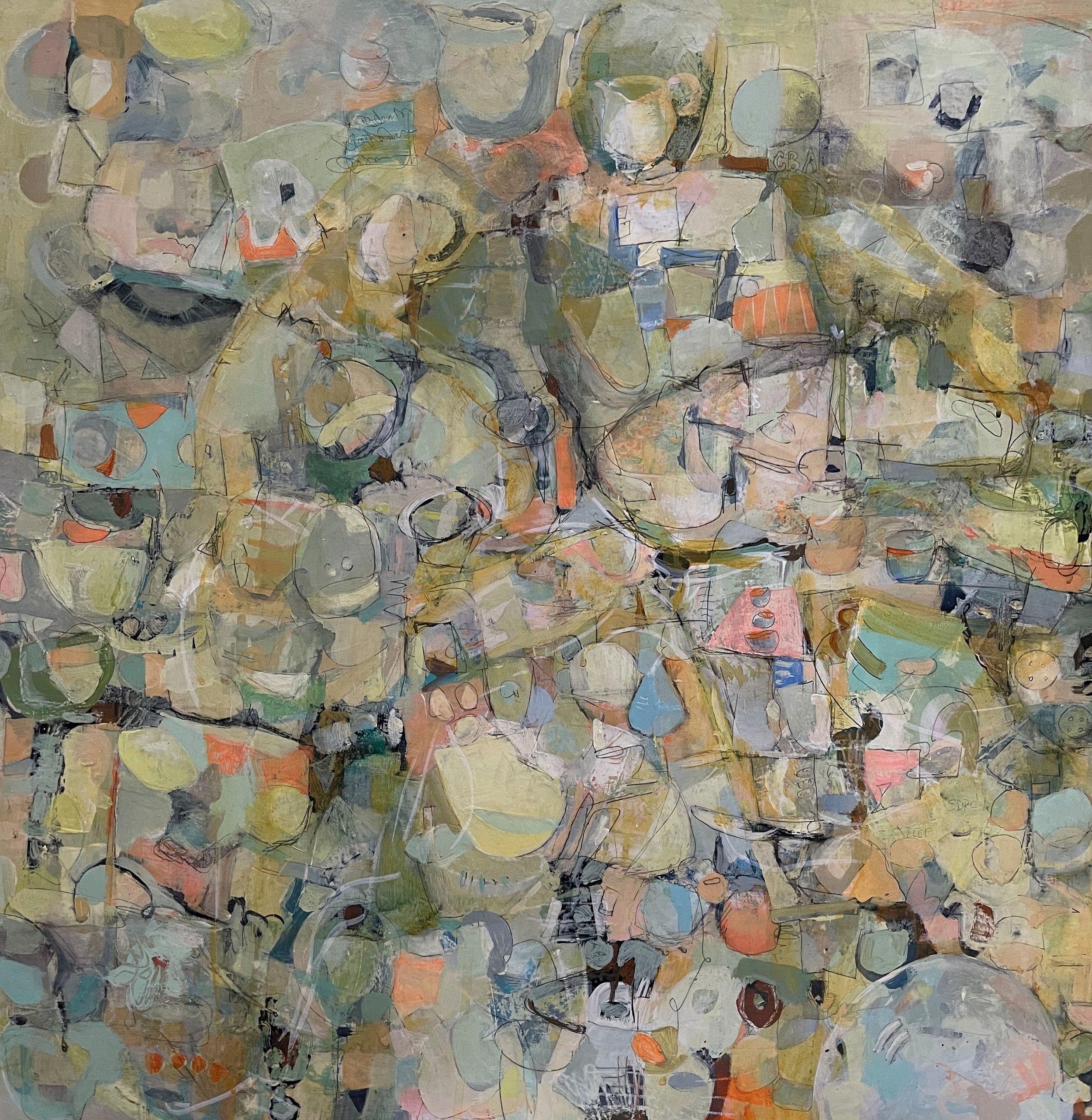Interview with Paula Borsetti

“I once envisioned myself as a graphic designer, but everything changed after my first painting class. I fell head over heels for painting—its textures, colors, tools, sensations, and the unique experience of creating something entirely new. It’s a sensory delight.”
Your art is described as an exploration and play, drawing inspiration from the natural world around you and personal connections to family and past experiences. How do these diverse influences manifest in your abstract paintings, and how do you navigate the balance between personal narrative and abstract expression?
Since the beginning of my artistic journey, I've felt compelled to capture the essence of my experiences. Growing up in Beverly and spending summers in Maine, the coastal and lakeside environment has become integral to my art, evident in the colors and shapes of New England that permeate my work. Raised in a creatively vibrant household, curiosity and the joy of discovery have become ingrained in my identity. I thrive on experimentation and fully immerse myself in the creative process, allowing the painting to evolve organically before making decisive choices. My diverse experiences - from learning and managing to caregiving and kayaking - subtly influence my abstract work. While my art is abstract, it carries a narrative that gradually unfolds with each viewing. I strive to evoke excitement in viewers through moments where marks intersect, colors harmonize, and shapes evoke memories, spaces, and emotions.
Having recently retired from a 26-year teaching career at Beverly High School, how has the shift to focusing on your own artistic practice impacted your creative process and the themes you explore in your work?
I like to think I transitioned from teaching into the path I was always meant for. Teaching was a fulfilling chapter in my life, and I'm grateful for the journey that enriched it. Whether in the classroom or my studio, learning is a constant, bringing joy in moments of discovery. While teaching, I maintained my studio practice, but now, having dedicated time for my work is a true blessing. Daily, I immerse myself in my studio, participating in local and online art communities, fostering growth as an artist. While my themes have long revolved around nature and personal stories, I now delve deeper into their essence, creating work that truly reflects why I paint. This newfound time allows me to explore, reflect, and progress with excitement.
In addition to your personal studio work, you and your husband established Locust Street Studios, collaborating on various projects like custom painted paddles, shaped signs, and hand-carved/painted whirligigs. How does this collaborative work complement or influence your individual artistic practice, and what role does it play in your creative journey?
Paintings that emanate from my heart require a considerable amount of creative energy. Sometimes, between projects or upon concluding a series, I appreciate engaging in a project that demands less emotional investment. This is where collaborative works come into play. They offer a meditative, enjoyable experience while still serving as instruments for learning. Each of these pieces involves a component of research, challenge, or problem-solving. They serve as another avenue for expressing my voice to the world.
Your abstract paintings are said to tell a story of your life, investigating the experience of being a woman in her 60s and navigating expectations while pushing past limiting beliefs. Could you elaborate on how your art serves as a medium for self-reflection and storytelling, capturing personal moments and narratives?
Ah, here I am, a woman in my 60s. Am I really? I feel like a kid in a candy shop. There is so much for me to learn, and I am grateful for that. Yet, I often feel that there is an expectation for me to have reached a certain point, but I am just getting started on this journey. I am interested in reflecting on what I have been doing as a daughter, sister, wife, mother, bookkeeper, friend, teacher, and nana. How these labels I have had for myself have shaped my journey. How the title of artist was always a middle name. That is a limiting belief that I am working with in my current series of work, "Fear of Flying." I am interested in researching and creating work about the barriers - real or perceived - that could keep me from soaring and breaking through them. This series explores those questions, with each piece tackling a different barrier. I love being surrounded by the tools of my trade. My studio is just a few steps outside my back door. I have everything at my fingertips. Each day, I am eager to get into the studio and see what bubbles up, what the works have to teach me about how to tell my story.
Your dedication to raising awareness and funds for ALS research is evident in your PALS series, inspired by Bobby Forster's courageous battle with ALS. How does your art contribute to the cause, and what role do you believe art can play in creating awareness and fostering empathy for important issues?
In the winter of 2013, my dear friend's son, Bobby, was diagnosed with ALS at the age of 25. Knowing that my art was my only means of support, I dedicated myself to raising awareness and funds for him over the course of 9 ½ years. Through art shows, painting, selling merchandise, and starting a business, I did everything in my power to contribute. Two projects stood out during this time. Upon leaving my job as a high school art teacher, I embarked on creating a significant body of work reflecting Bobby’s journey and its impact on those around him. This endeavor was more than just fundraising; it was about introspection, healing, and giving voice to unspoken emotions. Inspired by a moment at the beach, where I observed the hidden depths beneath the surface, I sought Bobby’s blessing to commence this series, which I believe he would have been proud of. Each piece began with words from Bobby or his caregiver, evolving into its own narrative. Two paintings from this series were transformed into designs for custom Birkenstocks, in collaboration with Michael Grey sandal factory, with proceeds benefiting Bobby’s care. These paintings were showcased in an online solo exhibition titled “Tending Below the Surface” through Women Art United Movement in March 2023.
Over the past decade, I have tirelessly worked to raise awareness and funds for ALS. When Bobby passed away in June 2023, I felt a sense of loss and uncertainty about my mission. Despite my efforts, I couldn't fulfill my hope of finding a cure in time for him. Nevertheless, I press on, fueled by the strength and resilience of those affected by ALS. I am determined to continue my artistic journey, knowing that one day, I will make a difference with my art. For me, art is not just a form of expression; it is a healing journey.
You mention being fascinated by the act of painting and the interplay between movement, materials, thoughts, and feelings in your artistic process. How do you see these elements converging in your work, and what significance does the tortoise and the hare metaphor hold in your exploration of these formal elements?
I once envisioned myself as a graphic designer, but everything changed after my first painting class. I fell head over heels for painting—its textures, colors, tools, sensations, and the unique experience of creating something entirely new. It's a sensory delight.
Each painting journey begins with preparing the canvas, a slow, deliberate process where I seal, gesso, or tape edges, immersing myself in the surface's space. Working on multiple pieces simultaneously, I transition from meticulous preparation to a rapid, intuitive dance across the surfaces. Using my non-dominant hand, I make initial marks, often writing in reverse, disrupting the canvas while mentally mapping its dimensions.
As I delve into choosing color palettes and application tools, the pace varies—sometimes methodical, sometimes impulsive. I stand, moving between palette and canvas, making marks, experimenting with texture and composition. Occasionally, I'll even grab a sander to unearth layers beneath. Throughout, I trust my intuition while considering formal elements like line, shape, and color.
Eventually, amidst the chaos, the painting guides me to slow down, urging a more deliberate approach. These final stages are serene, a tranquil resolution to the earlier frenzy—a moment of clarity when the artwork whispers, "I am complete."





